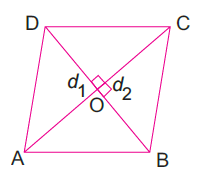Area of a Rhombus
A rhombus is a special type of parallelogram
in which all the sides are equal and the diagonals bisect each other at right
angles. To find the area of rhombus, we use the method of splitting the
quadrilateral into two triangles.
We know that the area of a triangle = ½ × base × height
Area of rhombus ABCD = Area of ΔABC +
Area of ΔADC
= ½ × AC × BO + ½ × AC × DO
= ½ ×
AC × (BO + DO)
= ½ × AC × BD
= ½ ×
d1 × d2
Thus, Area of a rhombus =
½ × d1 × d2
Where d1 and d2 are the diagonals of the rhombus.
Area of a Rhombus Formula
Hence, the area of a rhombus is equal
to half of the product of its diagonals.
If the base and the altitude of a
rhombus is given, then we can find the area of a rhombus using the formula of the area of a parallelogram.
Area of a rhombus = b × h
How to Find the Area of a Rhombus When Diagonals are Known
Consider a rhombus ABCD with two diagonals AC and BD.
- Step 1: Find the length of both the diagonals, d1 and d2.
- Step 2: Multiply both the lengths, d1 and d2.
- Step 3: Divide the result by 2.
The resultant value will give the area of the rhombus ABCD.
How to Find the Area of a Rhombus When The Base and The Height are Known
The resultant value will give the area of the rhombus.
Solved Questions on Area of a Rhombus
Example 1: The
lengths of the diagonals of a rhombus are 16 cm and 20 cm. Find its area.
Solution:
Here, d1 = 16 cm and d2 = 20 cm
Area of a rhombus = ½ × d1
× d2
= ½ × 16 × 20
= 160 sq. cm
Example 2: Find
the area of a rhombus, the lengths of whose diagonals are 30 cm and 40 cm.
Solution:
Here, d1 = 30 cm and d2 = 40 cm
Area of a rhombus = ½ × d1
× d2
= ½ × 30 × 40
= 600 sq. cm
Example 3: The
area of a rhombus is 250 sq. cm. If one of its diagonals is 20 cm long, find
the length of the other diagonal.
Solution:
Here, d1 = 20 cm and d2 = ?
Area of a rhombus = 250 sq. cm
Area of a rhombus = ½ × d1
× d2
250 = ½ × 20 × d2
500 = 20 × d2
d2 = 500/20 = 25 cm
Hence, the length of the other
diagonal is 25 cm.
Example 4: The
perimeter of a rhombus is 40 cm and one of its diagonals is 16 cm. Find the
length of the other diagonal. Also, find the area of the rhombus.
Solution: Perimeter
of the rhombus = 40 cm
Side of the rhombus = 40/4 = 10 cm
In the above figure, AB = BC = CD = AD
= 10 cm
Let the diagonal AC = 16 cm
Then, OC = AO = 8 cm
In right-angles triangle AOB,
OB2 = AB2 – AO2 [Using Pythagoras theorem]
OB2 = 102 – 82
OB2 = 100 – 64
OB2 = 36
OB = 6 cm
Thus, the diagonal BD = 12 cm
Now, Area of a rhombus = ½ × d1
× d2
= ½ × 16 × 12
= 96 sq. cm
Example 5: If the base and the perpendicular height of a rhombus measure 5.5 cm and 4 cm respectively, find the area of the rhombus.
Solution: Here, b = 5.5 cm and h = 4 cm
Area of a rhombus = b × h
= 5.5 × 4
= 22 sq. cm
Example 6: The perpendicular height of a rhombus is 6 cm. If the area of the rhombus is 27 sq. cm, find the side of the rhombus.
Solution: Here, h = 6 cm and area = 27 sq. cm
Area of a rhombus = b × h
27 = b × 6
b = 27/6 = 4.5 cm
Thus, each side of the rhombus is 4.5 cm.
To find the area of a trapezium, a parallelogram, a square, a rectangle and a circle, click the following links:

